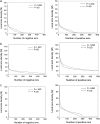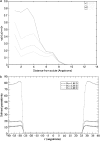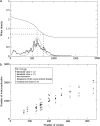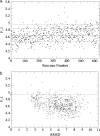Incorporating dipolar solvents with variable density in Poisson-Boltzmann electrostatics
- PMID: 18820239
- PMCID: PMC2599837
- DOI: 10.1529/biophysj.108.131649
Incorporating dipolar solvents with variable density in Poisson-Boltzmann electrostatics
Erratum in
- Biophys J. 2009 Mar 4;96(5):2043
Abstract
We describe a new way to calculate the electrostatic properties of macromolecules that goes beyond the classical Poisson-Boltzmann treatment with only a small extra CPU cost. The solvent region is no longer modeled as a homogeneous dielectric media but rather as an assembly of self-orienting interacting dipoles of variable density. The method effectively unifies both the Poisson-centric view and the Langevin Dipole model. The model results in a variable dielectric constant epsilon(r) in the solvent region and also in a variable solvent density rho(r) that depends on the nature of the closest exposed solute atoms. The model was calibrated using small molecules and ions solvation data with only two adjustable parameters, namely the size and dipolar moment of the solvent. Hydrophobicity scales derived from the solvent density profiles agree very well with independently derived hydrophobicity scales, both at the atomic or residue level. Dimerization interfaces in homodimeric proteins or lipid-binding regions in membrane proteins clearly appear as poorly solvated patches on the solute accessible surface. Comparison of the thermally averaged solvent density of this model with the one derived from molecular dynamics simulations shows qualitative agreement on a coarse-grained level. Because this calculation is much more rapid than that from molecular dynamics, applications of a density-profile-based solvation energy to the identification of the true structure among a set of decoys become computationally feasible. Various possible improvements of the model are discussed, as well as extensions of the formalism to treat mixtures of dipolar solvents of different sizes.
Figures










Similar articles
-
PDB_Hydro: incorporating dipolar solvents with variable density in the Poisson-Boltzmann treatment of macromolecule electrostatics.Nucleic Acids Res. 2006 Jul 1;34(Web Server issue):W38-42. doi: 10.1093/nar/gkl072. Nucleic Acids Res. 2006. PMID: 16845031 Free PMC article.
-
A self-consistent phase-field approach to implicit solvation of charged molecules with Poisson-Boltzmann electrostatics.J Chem Phys. 2015 Dec 28;143(24):243110. doi: 10.1063/1.4932336. J Chem Phys. 2015. PMID: 26723595 Free PMC article.
-
Simultaneous Identification of Multiple Binding Sites in Proteins: A Statistical Mechanics Approach.J Phys Chem B. 2021 May 20;125(19):5052-5067. doi: 10.1021/acs.jpcb.1c02658. Epub 2021 May 11. J Phys Chem B. 2021. PMID: 33973782
-
Electrostatics calculations: latest methodological advances.Curr Opin Struct Biol. 2006 Apr;16(2):142-51. doi: 10.1016/j.sbi.2006.03.001. Epub 2006 Mar 15. Curr Opin Struct Biol. 2006. PMID: 16540310 Review.
-
Biomolecular electrostatics and solvation: a computational perspective.Q Rev Biophys. 2012 Nov;45(4):427-91. doi: 10.1017/S003358351200011X. Q Rev Biophys. 2012. PMID: 23217364 Free PMC article. Review.
Cited by
-
On the ability of molecular dynamics simulation and continuum electrostatics to treat interfacial water molecules in protein-protein complexes.Sci Rep. 2016 Dec 1;6:38259. doi: 10.1038/srep38259. Sci Rep. 2016. PMID: 27905545 Free PMC article.
-
Adapting Poisson-Boltzmann to the self-consistent mean field theory: application to protein side-chain modeling.J Chem Phys. 2011 Aug 7;135(5):055104. doi: 10.1063/1.3621831. J Chem Phys. 2011. PMID: 21823735 Free PMC article.
-
Understanding nucleic acid-ion interactions.Annu Rev Biochem. 2014;83:813-41. doi: 10.1146/annurev-biochem-060409-092720. Epub 2014 Mar 5. Annu Rev Biochem. 2014. PMID: 24606136 Free PMC article. Review.
-
Computing ion solvation free energies using the dipolar Poisson model.J Phys Chem B. 2009 Apr 30;113(17):5694-7. doi: 10.1021/jp9010907. J Phys Chem B. 2009. PMID: 19385689 Free PMC article.
-
Molecular docking as a popular tool in drug design, an in silico travel.Adv Appl Bioinform Chem. 2016 Jun 28;9:1-11. doi: 10.2147/AABC.S105289. eCollection 2016. Adv Appl Bioinform Chem. 2016. PMID: 27390530 Free PMC article. Review.
References
-
- Orozco, M., and J. Luque. 2000. Theoretical methods for the description of the solvent effect in biomolecular systems. Chem. Rev. 100:4187–4226. - PubMed
-
- Perutz, M. 1976. Electrostatic effects in proteins. Science. 201:1187–1191. - PubMed
-
- Honig, B., and A. Nicholls. 1995. Classical electrostatics in biology and chemistry. Science. 268:1144–1149. - PubMed
-
- Marcus, R. 2006. Enzymatic catalysis and transfers in solution. J. Chem. Phys. 125:194504–194524. - PubMed
-
- Simonson, T., and B. Roux. 1999. Implicit solvent models. Biophys. Chem. 78:1–20. - PubMed
Publication types
MeSH terms
Substances
Grants and funding
LinkOut - more resources
Full Text Sources

